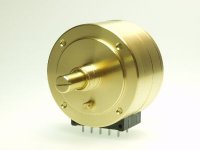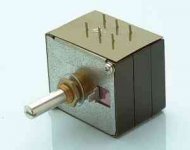1audio said:For the truly obsessive here is an article on IM distortion in passive attenuators using relays IM in Attenuators
Interesting, but is it relevant? Does IM distorsion at near-GHz frequencies tell us much about IM at audio frequencies?
1audio said:"I preferred the larger Alps pots but those are ancient history. The Taiwan and Chinese copies of the Alps and Noble pots are nowhere near as good with at least 20 dB more distortion. "
Hello 1AUDIO
I still think you can get real ALPS post, why are they history.
Regards
Arthur
Sigurd Ruschkow said:Demian,
I have sonically never liked the ALPS 'black' or 'blue' that many amps use.
Do you have any measurements on those?
Sigurd
Hello Sigurd
What pot do you like that gives the same functionality as the Alps.
Regards
Arthur
Maybe one of the gentleman finds the time to comment on R-core transformers?
I've seen they're used in the JC 2-preamp from Parasound, so maybe Mr. Curl could take time to comment? But maybe it was just Parasound's decision?
Is there any advantage in using them? Low magnetic stray fields?
Have fun, back to calling names now, Hannes
I've seen they're used in the JC 2-preamp from Parasound, so maybe Mr. Curl could take time to comment? But maybe it was just Parasound's decision?
Is there any advantage in using them? Low magnetic stray fields?
Have fun, back to calling names now, Hannes
Originally posted by Christer
...your opinion about a buffer before the pot...
Less is better.
I once built an active x-over with a simple JFet source follower and a current diode load. The veiling introduced is hard to believe. I promptly removed it from the mid/hi channel and have been living happily ever after with a simple (styroflex) capacitor 1st order HPF.
IM distortion the GHz range may not indicate anything in the audio range, but it might. And measuring it will not be easy. And its audibility remains an open question. But I think its a serious mistake to reject out of hand the issue. The article points out that even in radio communications, an arena where a lot of serious, very valuable work has been done and astonishing amounts of money have been spent, an issue that was thought to be unimportant turned out to be critical.
If we went by the conventional wisdom audio is 20-20K, .1% THD and MP3 at 384 KHz. Job done. And since most recording microphones have limited output above 15KHz maybe 20KHz is too much. You would not be here if you actually believed this.
The Alps pot in question was larger than the current ones. It had a series of thick film laser trimmed resistors and contact pads on the substrate for each channel. When i tried to get them for a project recently they weren't available any more. And they never existed in a motorized version that I know of.
I may set up the pot distortion test again and document it, and measure a few samples.
I forgot the other clear winner. Vishay makes a rectangular trimmer with the bulk metal foil construction. it was on a par with any other I tried. BUT you need a screwdriver to adjust it. Vishay trimmer The sales guy told me many years ago that they made an audio taper version of the round pattern for a hearing aid company that was looking for a low noise pot. No one I have talked to at Vishay in the last ten years knows anything about that project.
If we went by the conventional wisdom audio is 20-20K, .1% THD and MP3 at 384 KHz. Job done. And since most recording microphones have limited output above 15KHz maybe 20KHz is too much. You would not be here if you actually believed this.
The Alps pot in question was larger than the current ones. It had a series of thick film laser trimmed resistors and contact pads on the substrate for each channel. When i tried to get them for a project recently they weren't available any more. And they never existed in a motorized version that I know of.
I may set up the pot distortion test again and document it, and measure a few samples.
I forgot the other clear winner. Vishay makes a rectangular trimmer with the bulk metal foil construction. it was on a par with any other I tried. BUT you need a screwdriver to adjust it. Vishay trimmer The sales guy told me many years ago that they made an audio taper version of the round pattern for a hearing aid company that was looking for a low noise pot. No one I have talked to at Vishay in the last ten years knows anything about that project.
The Alps pot in question was larger than the current ones.
Are you talking about this one?
http://cgi.ebay.de/ALPS-Super-High-...ryZ12078QQssPageNameZWDVWQQrdZ1QQcmdZViewItem
Attachments
Rcore or the equivalent transformers are better than toroid, by far, and even preferred in some ways over a good E-I transformer, because they have higher high frequency isolation than a toroid.
PHEONIX said:
Hello Sigurd
What pot do you like that gives the same functionality as the Alps.
Regards
Arthur
Arthur,
I started using stepped attenuators instead.
Sigurd
That Alps pot is not what I was referring to. The older one was black in a diecast housing about 35mmX30mm I think, and had discrete steps. The specs on the pot you highlighted are pretty pedestrian with tracking at 3 dB if I read the sheet correctly. The old part was spec'd at .5 db and usually closer to .1 db. Really hard to do unless its discrete resistors.
Tokyo Ko-an also makes good pots if you can get them.
Tokyo Ko-an also makes good pots if you can get them.
If i can get one of the Alps black or blue pots I'll measure it. The same for the equivalent Nobel. I have been told that the Nobels sound better but have no personal experience.
Maybe it was this Alps pot (click on second M.E. link in Lab Zero Preamp >) http://www.thevintageknob.org/SONY/sonyesprit/wega/LABZERO.html#
Also, here: http://www.thevintageknob.org/SONY/sonyesprit/TAE88/TAE88.html
Also, here: http://www.thevintageknob.org/SONY/sonyesprit/TAE88/TAE88.html
john curl said:Rcore or the equivalent transformers are better than toroid, by far, and even preferred in some ways over a good E-I transformer, because they have higher high frequency isolation than a toroid.
Toroids can have good high frequency isolation (another way of saying low interwinding capacitance) if they're made with a Faraday shield between primary and secondary, which most off-the-shelf toroids do not have.
Personally I've always liked the dual, split bobbin, UI power transformers.
se
1audio said:IM distortion the GHz range may not indicate anything in the audio range, but it might. And measuring it will not be easy. And its audibility remains an open question. But I think its a serious mistake to reject out of hand the issue. The article points out that even in radio communications, an arena where a lot of serious, very valuable work has been done and astonishing amounts of money have been spent, an issue that was thought to be unimportant turned out to be critical.
I agree that it could be relevant, but we don't know, do we? Perhaps there is more IM at audio frequencies, perhaps there is less, perhaps the relative performance changes too. If memory doesn't fail me, in a discussion about PIM once, we found articles about connectors causing PIM at very high frequencies. That was an interesting surprise to some of us. However, does that have any relevance at audio frequencies? I don't think even John has ever suggested connectors as a source of PIM in audio.
Sometimes we know how a phenomenon changes with frequency, making it possible to extrapolate results to some degree between frequency bands. I don't think we have such knowledge in this case, making such extrapolations pure guesswork.
Steve Eddy said:Toroids can have good high frequency isolation (another way of saying low interwinding capacitance) if they're made with a Faraday shield between primary and secondary, which most off-the-shelf toroids do not have.
Personally I've always liked the dual, split bobbin, UI power transformers.
se
Hi Steve,
Hypex sells toroids with a shield between the windings:
http://www.hypex.nl/
Cheers,
Edmond.
Gold on gold for fixed contacts. This is real problem with pot connectors that are often added to mount the pots off the motherboard easily.
- Status
- Not open for further replies.
- Home
- Amplifiers
- Solid State
- John Curl's Blowtorch preamplifier


